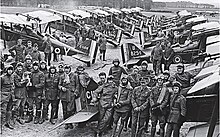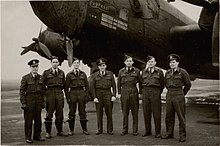
This is a list of personnel numbers in the Royal Air Force, from its inception in 1918, up until the modern day. Royal Air Force staffing numbers have fluctuated with periodic demand, however, since the end of the Second World War, numbers have decreased steadily and the RAF itself has shrunk in terms of operating bases. Several schemes have been implemented during times of excess staffing to reduce numbers.
History
Several programmes were introduced over the life of the Royal Air Force with a view to either reducing, or increasing personnel in line with current threats, or loss of a perceived threat, such as after the First and Second World Wars. Other programmes were developed outside of conflict such as the Options for Change in 1990 (end of the Cold War), and the Defence Costs Study (or Front Line First) in 1994. Post First World War saw a huge reduction in staffing and aircraft, though recruitment did continue apace. One notable exception was the Women's Royal Air Force (WRAF) which was disbanded completely in 1920. At Armistice Day in 1918, the fledgling Royal Air Force consisted of a combined personnel of 291,170, which was expected to be reduced to 60,000 by 1 October 1919. In fact, by October 1919, the numbers had dropped to 58,000, increasing fears within the Royal Air Force that it would cease to be an independent air force, and be subsumed into either the Navy or the Army. In 1925, the government announced plans to temporarily cease the expansion of the RAF, and it dropped in numbers between 1926 and 1927 from 33,500 to 33,009.
In response to German re-armament, particularly that of the Luftwaffe, an expansion of the RAF was announced in May 1935, stating a near trebling of aircraft and staff by the end of the next financial year (31 March 1937), resulting in an additional 22,500 personnel.
A re-assessment of necessary staffing after the end of the Cold War, prompted a Defence review called Options for Change. This scaled the Air Force at 75,000, having previously had a strength up to 1990 of 88,500. However, further cuts were implemented during 1993 which were not part of the original Options paper after natural wastage did not produce enough of a drop in numbers, and with the additional loss of one Tornado squadron in the meantime; estimates were recalculated to 70,000. Large swathes of redundancies were served upon all three strands of the UK military structure in 1995. This saw at least 9,000 redundancies, of which, 7,500 were in the Royal Air Force alone.
Full time personnel were offset in loss of numbers by the uplift of Reserve Personnel as per a government directive to increase the number of reservists. This can be seen by the increase of reservists, of which the percentage of reservists expanded two and half times over between October 2013 and October 2021.
Example personnel numbers




| Date | Numbers | Notes | Ref |
|---|---|---|---|
| November 1918 | 291,170 | To reduce to around 60,000 by late 1919 | |
| April 1919 | 149,196 | 17,267 officers, 108,753 other ranks, the remainder were WRAF | |
| October 1919 | 58,000 | ||
| January 1920 | 26,682 | After the demobilisation, the strength of the RAF was one tenth of what it was at the Armistice | |
| 1927 | 33,009 | Down from 35,300 in 1926 | |
| 1929 | 28,638 | 3,338 officers, 25,300 other ranks | |
| January 1934 | 30,381 | 3,334 officers, 25,170 other ranks, 1,877 apprentices and cadets | |
| May 1936 | 32,456 | Increase during the expansion period | |
| September 1939 | 175,392 | Around 118,000 estimated to be in all areas of operation apart from India | |
| April 1944 | 1,185,913 | 88,615 officers, 922,892 other ranks, 174,406 WRAF | |
| May 1945 | 1,079,835 | ||
| 1952 | 270,000 | ||
| April 1958 | 210,000 | A cut of 20,000 personnel from April 1957. | |
| 1960 | 163,800 | 73,000 civilians | |
| 1962 | 148,000 | ||
| 1970 | 108,800 | 15,400 civilians | |
| 1976 | 96,300 | ||
| September 1978 | 84,792 | ||
| September 1979 | 87,392 | ||
| 1981 | 91,965 | ||
| September 1982 | 89,254 | ||
| April 1989 | 93,100 | 14,400 officers, 72,500 other ranks, 6,200 WRAF | |
| July 1990 | 89,000 | ||
| 1993 | 70,000 | ||
| April 1997 | 57,000 | Planned reduction to 56,000 by 1999 | |
| 2000 | 52,000 | ||
| December 2004 | 48,900 | Defence cuts estimated that a reduction of almost 8,000 to 41,000 by 2008 | |
| January 2018 | 36,960 | ||
| January 2021 | 32,920 | ||
| April 2022 | 33,320 | The numbers do not consist of reservist personnel. The Defence in a Competitive Age paper from the UK Government expects the RAF to number 31,750. |
Notes
- Not including those who were serving in India.
- In 1994, the WRAF was disbanded again, with most serving personnel moved into the RAF.
References
- ^ Armitage 1998, p. 269.
- Armitage 1998, p. 275.
- Philpott 2006, p. 267.
- ^ Philpott 2006, p. 269.
- ^ Sweetman, John (July 1984). "Crucial Months for Survival: The Royal Air Force, 1918-19". Journal of Contemporary History. 19 (3). London: Sage Publications: 533. ISSN 0022-0094.
- ^ Dawson, Geoffrey, ed. (7 March 1927). "Air Estimates". The Times. No. 44523. p. 9. ISSN 0140-0460.
- Dawson, Geoffrey, ed. (23 May 1935). "No Risks with Security; RAF to be nearly trebled". The Times. No. 47071. Column D. p. 8. ISSN 0140-0460.
- Holman, Brett (April 2011). "The Air Panic of 1935: British Press Opinion between Disarmament and Rearmament". Journal of Contemporary History. 46 (2): 296. doi:10.1177/0022009410392407. S2CID 143844858.
- ^ Evans, Michael (22 October 1993). "RAF men face sack in morning's post". The Times. No. 64781. p. 1. ISSN 0140-0460.
- Leathley, Arthur (17 December 1994). "9,000 face redundancy to meet defence cuts". The Times. No. 65140. p. 2. ISSN 0140-0460.
- "Armed forces plans criticised as reservist recruitment stalls". BBC News. 13 November 2014. Retrieved 10 July 2022.
- Harding, Megan (11 January 2022). "UK defence personnel statistics". House of Commons Research Briefings (7930). London: House of Commons: 19. OCLC 1029845664.
- Fowler et al. 1994, p. 7.
- ^ Armitage 1998, p. 277.
- Air Ministry - Pamphlet 152 - Twenty Five Years Of The RAF. London: Air Ministry. 1943. p. 6. OCLC 1043091902.
- Philpott 2006, p. 270.
- Sprigg, T Stanhope (1935). The Royal Air Force ; its organization, duties and prospects as a profession or a trade. Bath: Isaac Pitman & Sons. p. 3. OCLC 980692677.
- Dawson, Geoffrey, ed. (21 August 1936). "Expansion of the RAF". The Times. No. 47459. p. 10. ISSN 0140-0460.
- Wynn, Humphrey (September 1976). "The Royal Air Force: Its Origin and History, 1918-1970". Aerospace Historian. 23 (3). Air Force Historical Foundation: 162. ISSN 0001-9364.
- Dawson, Geoffrey, ed. (3 March 1939). "Air Estimates". The Times. No. 48244. p. 9. ISSN 0140-0460.
- Bowyer, Chaz (1984). Royal Air Force handbook, 1939-1945. London: I. Allan. p. 123. ISBN 0711013187.
- ^ Fowler et al. 1994, p. 100.
- Haley, William, ed. (26 April 1957). "R.A.F. To Be Cut 20,000 In Year". The Times. No. 53825. p. 6. ISSN 0140-0460.
- ^ Miller, T (January 1973). "Military Airfields and Rural Planning". Town Planning Review. 44 (1). Liverpool: University Press: 38. doi:10.3828/tpr.44.1.t302106j77w02883. ISSN 0041-0020. OCLC 664563272.
- Wynn, Humphrey (September 1976). "The Royal Air Force: Its Origin and History, 1918-1970". Aerospace Historian. 23 (3). Air Force Historical Foundation: 166. ISSN 0001-9364.
- ^ Stanhope, Henry (16 November 1979). "Forces' pay rises boost recruitment". The Times. No. 60476. p. 4. ISSN 0140-0460.
- Horseman, Martin, ed. (March 1982). "UK regular forces at five-year peak of personnel strength". Armed Forces. Shepperton: Ian Allan. p. 46. ISSN 0142-4696.
- Horseman, Martin, ed. (March 1983). "UK Services' personnel numbers decline". Armed Forces. Shepperton: Ian Allan. p. 89. ISSN 0142-4696.
- Stothard, Peter, ed. (25 February 1994). "WRAF will fly into the past". The Times. No. 64888. p. 9. ISSN 0140-0460.
- Stothard, Peter, ed. (3 March 1997). "The Facts". The Times. No. 65827. p. 6. ISSN 0140-0460.
- Evans, Michael (16 July 1998). "RAF seeks rising stars to join the ranks". The Times. No. 66255. p. 9. ISSN 0140-0460.
- Evans, Michael (10 December 2004). "Top brass among the first to go in £250m cull of RAF". The Times. No. 68255. p. 26. ISSN 0140-0460.
- ^ "Quarterly service personnel statistics 1 January 2021". GOV.UK. 9 December 2021. Retrieved 25 January 2022.
- Harding, Megan. "UK defence personnel statistics" (PDF). researchbriefings.files.parliament.uk. p. 6. Retrieved 4 July 2022.
- "Quarterly service personnel statistics 1 April 2022". GOV.UK. Retrieved 4 July 2022.
Sources
- Armitage, M. J. (1998). The Royal Air Force : an illustrated history. London: Brockhampton Press. ISBN 1860198511.
- Fowler, Simon; Elliott, Peter; Conyers Nesbit, Roy; Goulter, Christina (1994). RAF records in the PRO. London: PRO. ISBN 1873162146.
- Philpott, Ian M. (2006). The Royal Air Force : an encyclopaedia of the inter-war years. Barnsley: Pen & Sword. ISBN 1844153916.
| Royal Air Force | |||||||
|---|---|---|---|---|---|---|---|
| Ministry of Defence | |||||||
| formations and units |
| ||||||
| branches and components | |||||||
| reserve forces | |||||||
| equipment | |||||||
| personnel | |||||||
| appointments | |||||||
| symbols and uniform | |||||||
| associated civil organisations | |||||||